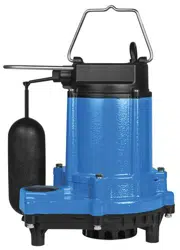Loading ...
Loading ...
Loading ...

4
INSTALLATION
s
!
WARNING Check local electrical and
building codes before installation. The installation must be in
accordance with their regulations as well as the most recent
National Electrical Code (NEC).
1. Pump must be installed in a suitable gas-tight basin that is at
least 18" in diameter and 24" deep and vented in accordance with
local plumbing codes.
(Note: for sump pump applications, an 18" x 22" deep
perforated basin can be used if in accordance to all
applicable plumbing codes.)
2. Clean any debris from the basin and set the pump in the center
of the basin (see “Typical Installation”). A solid bottom will
prevent clogging of the pump from sand and dirt.
3. The pump must be placed on a hard, level surface. Never place
the pump directly on clay, earth or gravel surfaces. These
surfaces contain small stones, gravel, sand etc. that may
clog or damage the pump and cause pump failure.
4. Do not attempt to restrict the intake side of these pumps.
Restricting the intake may cause damage to the seal and may
starve the pump. If you require reduced flow rates, place a valve
on the discharge side of the pump. Or, if flexible vinyl tubing is
used, a clamp can be used on the tubing to restrict the flow.
5. Connect discharge piping. Use pipe joint compound at all
connections. The discharge pipe should be as short as possible
and contain as few elbows as possible. The discharge pipe
should be the same diameter as the discharge size to reduce
pipe friction losses. A smaller pipe will restrict capacity and
reduce pump performance. The sump pump comes with a
1-1/2" female pipe thread discharge.
a. Support the pump and piping while assembling and when
installed. Failure to do so may cause the piping to break,
the pump to fail, motor bearing failures, etc.
b. Always install a union in the discharge line just above
the basin cover to allow for easy removal of the pump
for cleaning or repair.
6. A check valve must be used in the discharge line to prevent
backflow of liquid into the basin. The check valve should be a
free-flow valve that will easily pass solids.
a. s
!
CAUTION For best performance of the
check valve when handling solids, install it in a horizontal
position or at an angle of no more than 45°. Do not install
the check valve in a vertical position, as solids may settle in
the valve and prevent the valve from opening on start-up.
b. When a check valve is used, drill a relief hole (1/8" or 3/16"
in diameter) in the discharge pipe. This hole should be
located below the floor line between the pump discharge
and the check valve. Unless such a relief hole is provided,
the pump could “air lock” and will not pump water even
though it will run.
7. Tape the pump and switch cords to the discharge line with
electrical tape. This will protect the cord from damage.
8. Test the operation of the pump system by following the
instructions in the “System Operation Testing” section of this
manual. Do not attempt to operate the pump without water;
this will damage the seals and bearings and could result in
permanent damage to the pump.
9. Place cover over basin. This cover will help prevent debris from
entering the pit and will guard against accidental injury.
s
!
WARNING Always disconnect the electrical
power before touching the pump or discharge when water is present
in the basin. Failure to do so can result in hazardous electrical shock.
Loading ...
Loading ...
Loading ...
